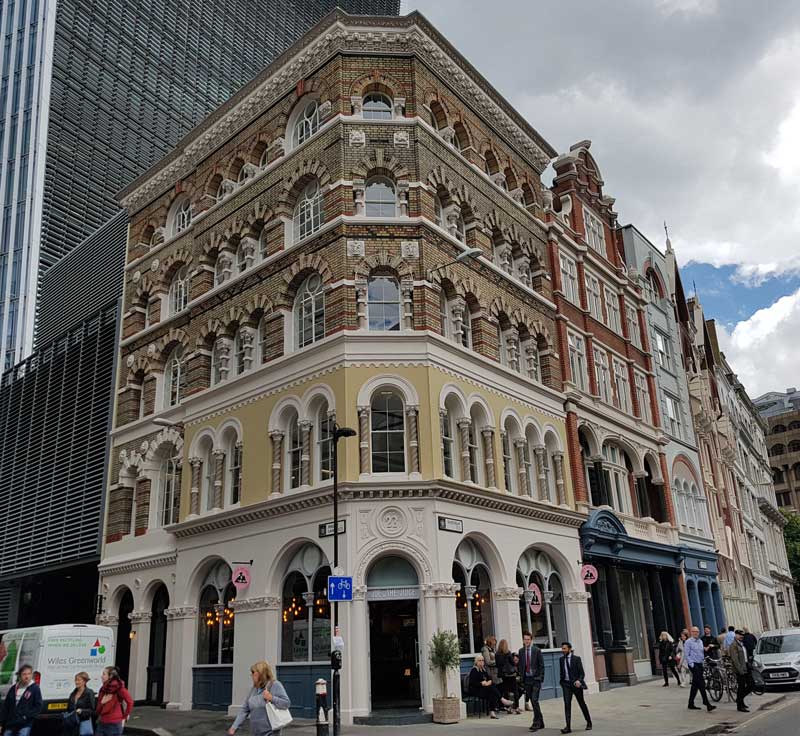
Philpot Lane is named for Sir John Philpot, who was Lord Mayor of London from 1378 to 1379.
Today, its most notable building is, undoubtedly, 20 Fenchurch Street - better known as the "Walkie Talkie" building, the visitor entrance to the Sky Garden of which is situated off Philpot Lane.
However, this little lane is well worth lingering along in order to feast your eyes on the buildings that line it, which date from various ages and which feature an eclectic array of architectural styles.
At the south end of Philpot Lane, at its junction with Eastcheap, you will find a building that seems to almost cower beneath the looming bulk of 20 Fenchurch Street, which rises, spectre-like, behind it.
This is 23 Eastcheap, and it was built between 1861 and 1862, as offices and warehousing for the spice-merchants Messrs.' Hunt and Crombie, to the design of the architectural practice of John Young and Son,
A recent re-paint has robbed the building of the riot of colour that once graced its facade, albeit the exquisite detail of its barley-twist columns can still be savoured by those who crane their necks to look up at it from the centre of Eastcheap; and the intrepid neck-craner will be further rewarded by a glimpse of the dogs and pigs heads which hide up in the eaves of the building.

However, as delightful as the exterior of number 23 Eastcheap undoubtedly is, the most curious feature to adorn its facade has to be a carving of two brown mice, each of which is engaged in a perpetual struggle to wrest a large chunk of cheese from the jaws of the other.
Now, it has to be said that, when it comes to a definitive reason for the presence of the battling vermin on this exterior wall of 23 Eastcheap, there isn't one.
It might just be that, having completed the building in 1862, one or more of the workmen of the company that constructed the property, Piper and Wheeler, decided to play a little joke for the sake of posterity by leaving behind a carving that would engage the minds of passersby for evermore.

However, over the years, all manner of colourful tales have sprung up to explain the presence of the wrestling rodents.
One story holds that, as work on the building progressed, the workmen became somewhat mystified by the fact that their packed lunches kept disappearing before they had had the chance to take a break and devour them.
Eventually, a careful watch was kept, and it was discovered that the culprits responsible for making off with the workmen's sarnies, were mice who had taken up residence around the emerging building.
The workmen decided to pay tribute to the cheeky creatures by carving their likenesses onto the finished building in remembrance of their lost lunches.
A more colourful version of the story holds that two workmen came to suspect each other of stealing one another's lunches and they got into an argument over the matter on the scaffolding.
Unfortunately, the rail they were fighting against suddenly broke and the two men plunged to their deaths.
When their colleagues discovered that the whole tragedy had come about as a result of mice actually devouring the lunches, they carved the two mice to commemorate their departed workmates.
Whatever the origins of the two mice on the exterior of the wall on Philpot Lane, there can be little doubt that they are now one of London's curiosities and, despite the fact that the mice themselves are a dull shade of brown, the legends that explain their origins are, to say the least, extremely colourful!